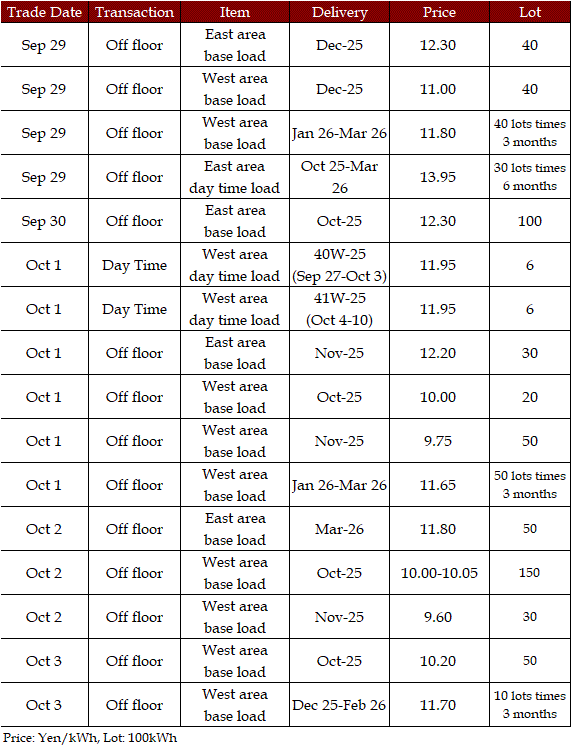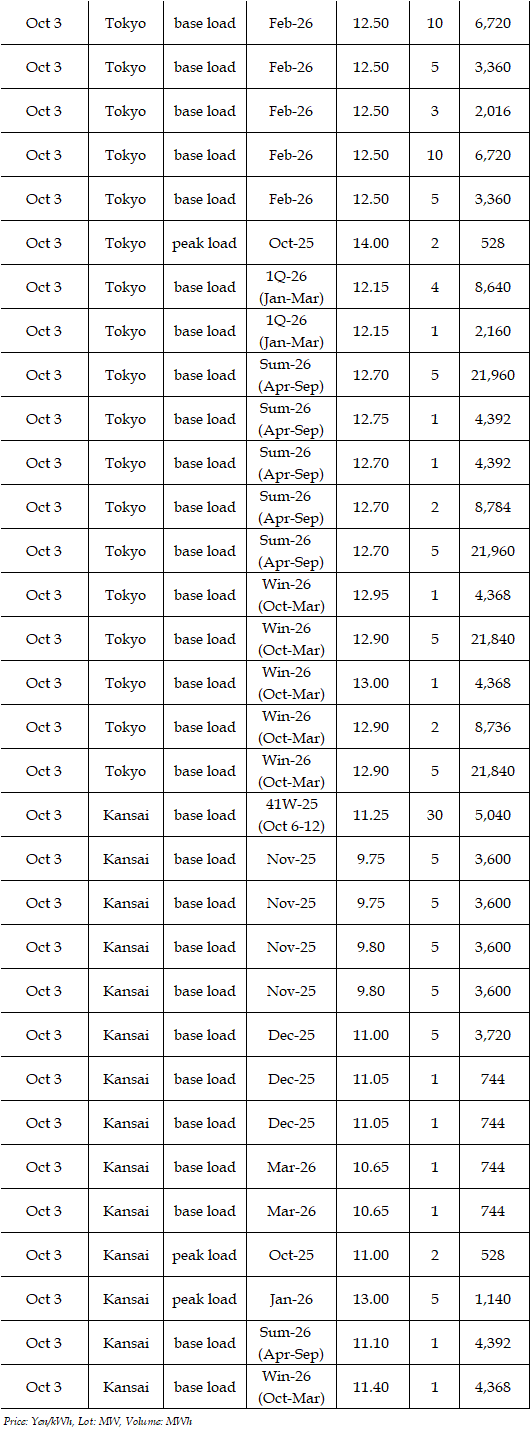Power: Sep 29-Oct 3: Spot price rebounds on increase in maintenance in thermal power plants
|
In the day-ahead market on JEPX (Japan Electric Power Exchange), the 24-hour spot power prices on a weekly average basis for Sep 29-Oct 3 delivery rebounded from the previous week in East Japan (50 Hz) as well as in West Japan (60 Hz). An increase in outages at thermal power plants due to maintenance from October, as well as more cloudy weather areas through the week, reduced offers sharply from a week earlier, which raised prices, along with an increase in bids. Prices, however, did not rise much with the upper bound of Yen 20 or lower because of easing hot temperatures.
The 24-hour spot average between Tokyo and Kansai, a major market area in East and West Japan, was Yen 3.29 on Sep 29, Yen 1.73 on Sep 30, Yen 1.93 on Oct 1, Yen 1.26 on Oct 2, and Yen 0.47 on Oct 3 in favor of the West.
The fuel market trends in the first week of October were detailed as follows.
DES Northeast Asia spot LNG prices on Oct 2 fell roughly by 40cts from the end of last week (Sep 26) to high-$10's per mmBtu for prompt November 2025 delivery. This marked the first time for the nearby contract to fall below $11.00 since late August. The softened natural gas markets in Europe sent the DES Northeast Asia market lower. In the DES Northeast Asia market, interests in the spot cargoes were not high because many end-users covered their demand with long-term contracts. The Ministry of Economy, Trade and Industry (METI) announced on Oct 1 that Japan's LNG inventories for power generation stood at 1.83 mil mt as of Sep 28, down 50,000 mt from a week before. The figure was the same as the end of September last year and below the average for the past five years (2.05 mil mt).
FOB Newcastle thermal coal prices in Australia were in the high-$104's per ton for October 2025 loading as of Oct 2, down around $1.5 from the previous week. A decline in gas and crude was priced in.
In the crude oil market, WTI crude for November 2025 stood in the high $60's per barrel at noon on Oct 2, while Brent crude for December 2025 was trading in the low-$64's. Prices fell by roughly $5.0 from the end of the previous week for WTI and Brent. Prices dropped on a possible further production raise by OPEC Plus as well as an increase in US inventory.
The actual highest price during the week was at Yen 19.21 in East Japan on Sep 29; the actual lowest price during the week was at Yen 0.01 in Shikoku on Sep 29-Oct 1.
By area, the weekly average of the 24-hour spot prices was at Yen 11.17 in Hokkaido, down Yen 0.02 from the previous week; Yen 11.05 in Tohoku, up Yen 1.44; Yen 12.39 in Tokyo, up Yen 1.63; Yen 11.14 in Chubu, up Yen 1.50; Yen 10.66 in Hokuriku and Kansai, up Yen 1.64; Yen 10.18 in Chugoku, up Yen 1.23; Yen 7.44 in Shikoku, down Yen 1.45; and Yen 10.07 in Kyushu, up Yen 1.13.
In the JEPX auction, the volume of offers was 1,161.60 mil kWh on a weekly average basis, down 12.4% from the previous week. Meanwhile, bids on a weekly average basis were up 6.4% to 1,091.66 mil kWh. The weekly average of trade volumes recorded 775.24 mil kWh, down 1.9%.
Power demand in nine areas of Japan during Sep 29-Oct 3 was a combined 11,130.27 mil kWh, down 1.3% from 11,281.34 mil kWh during Sep 22-26. The figure was up/down 3.6% from the corresponding period a year earlier, which was 11,544.29 mil kWh during Sep 30-Oct 4, 2024, after day-of-week adjustment.
Deals reported on TOCOM (Tokyo Commodity Exchange) during Sep 29-Oct 3 were as below.
Deals reported on EEX (European Energy Exchange) during Sep 29-Oct 3 were as below.
Prices for the second week in October would not change much from the first week. While temperatures in the first half of the week would be high at around 30 degrees, like a summer day, in and to the west of Kanto, they would turn lower toward the second half of the week, reducing demand. On the supply side, more cloudy days were to come across the nation, curbing outputs from photovoltaic power plants; however, a sunny spell would be spreading toward the end of the week, which could push daytime prices down to some degree. Asked about a price outlook, a source at a power producer and supplier said, "Base load prices in Tokyo will move at around Yen 13's in the first half of the week, then gradually turn lower to around Yen 12.00 at the end of the week. In Kansai, prices will be Yen 1.00 cheaper than those in Tokyo." The risk factor, however, could be trouble at the power plant; more power plants were under regular maintenance, as mentioned before, creating a situation of more upside risk in prices in case of trouble amid low supply capacity.
|
||||||||||||||||||||||||||||||















